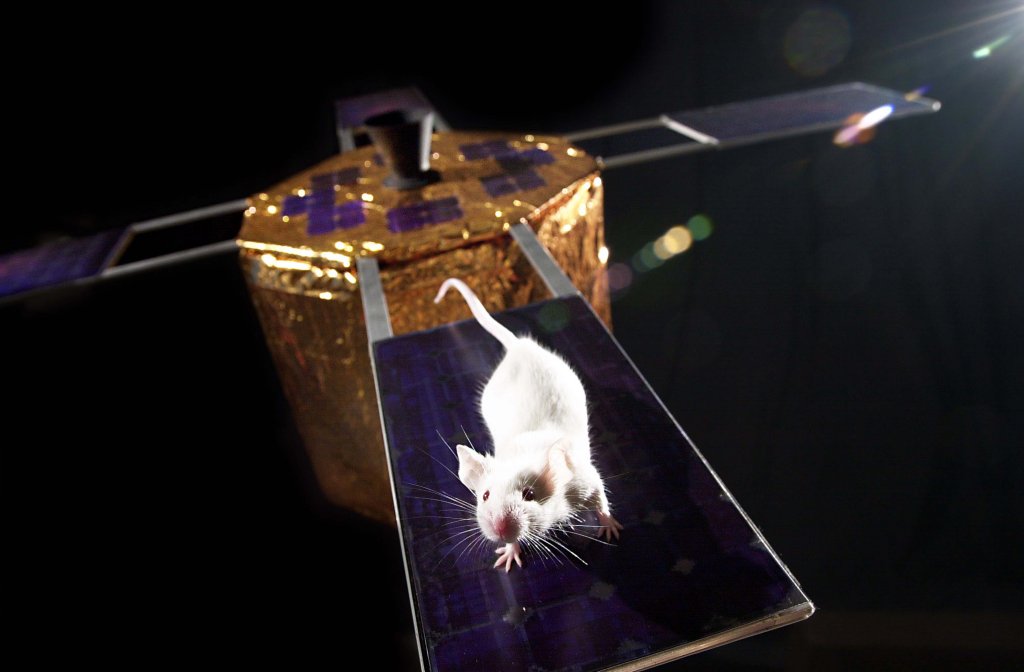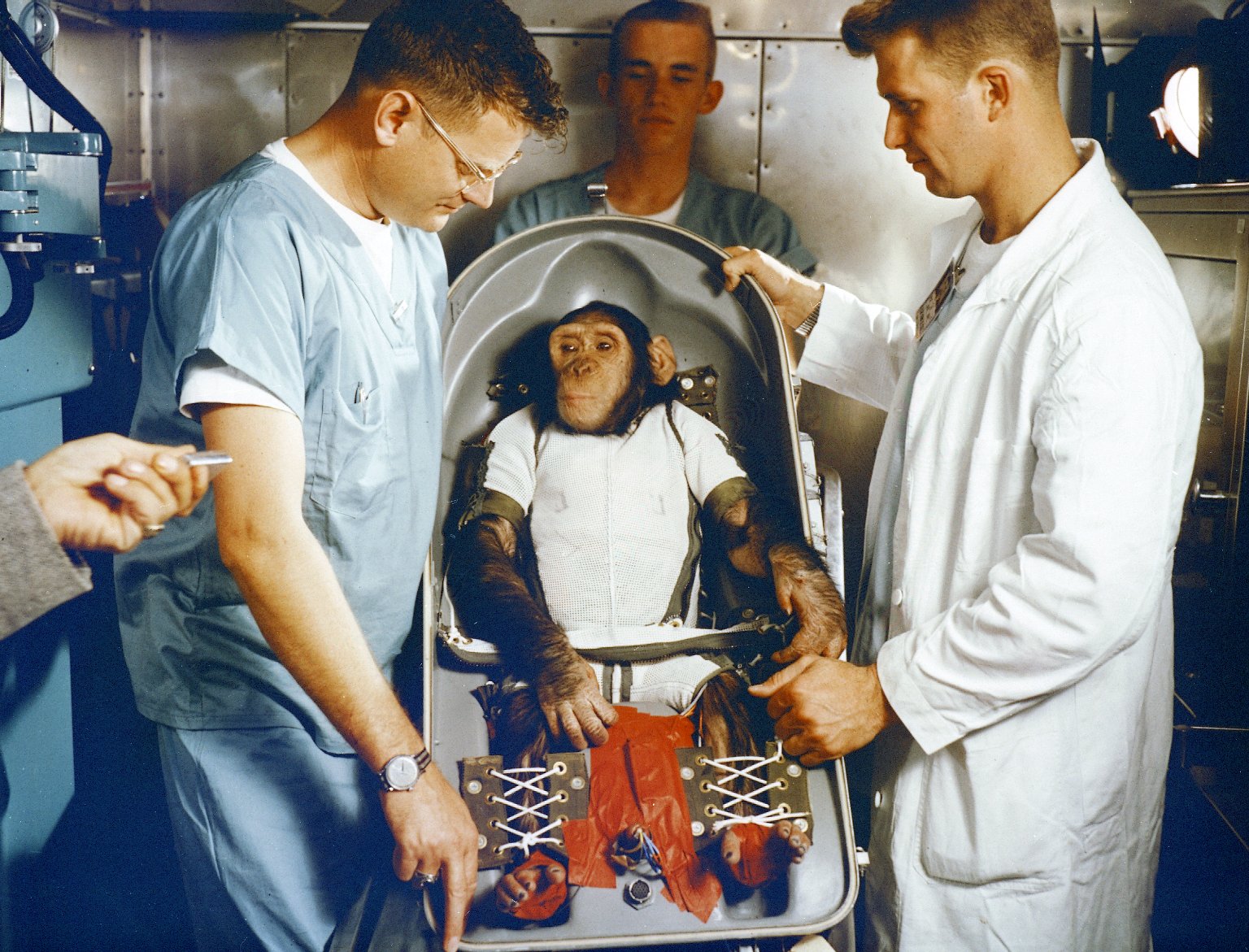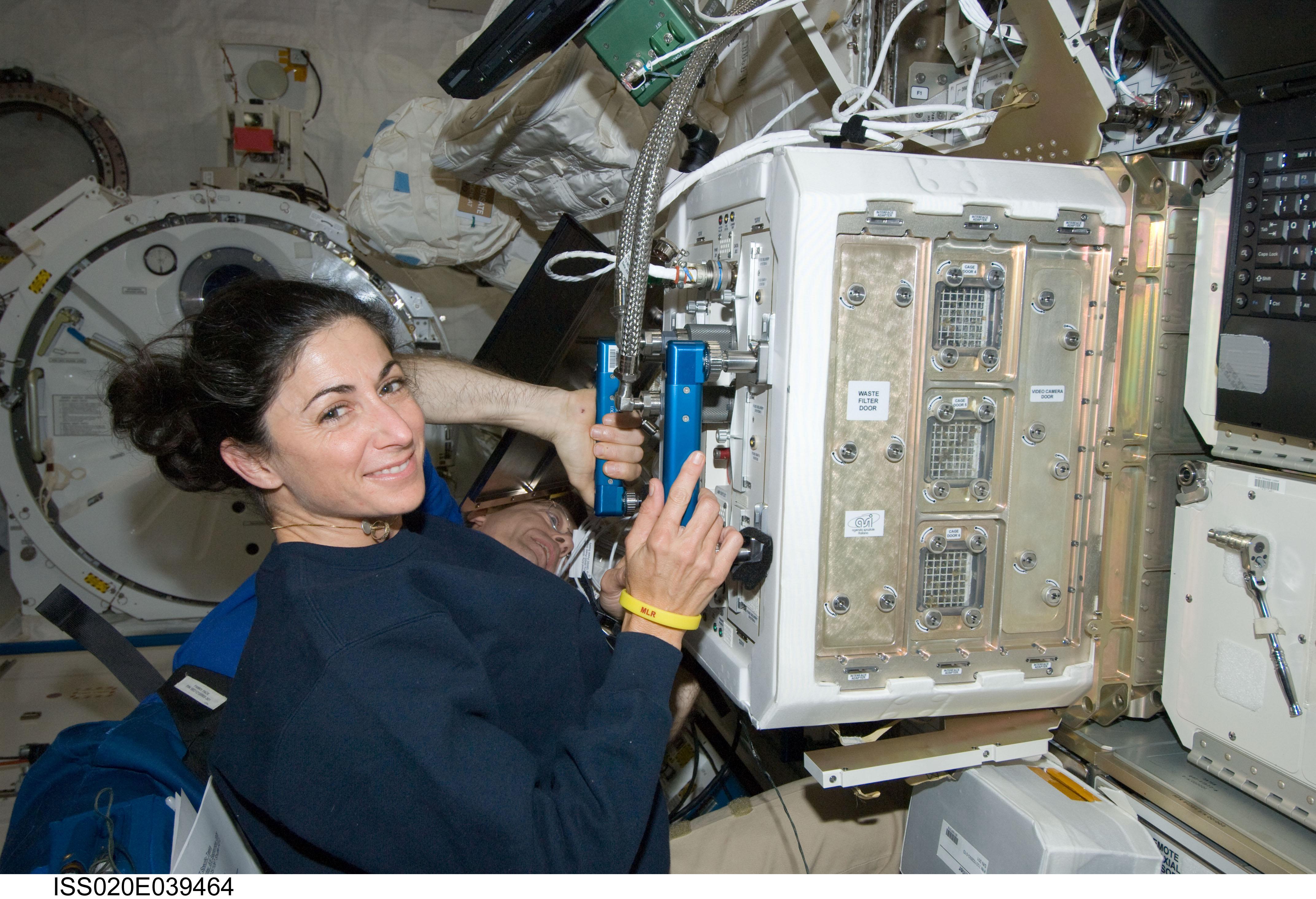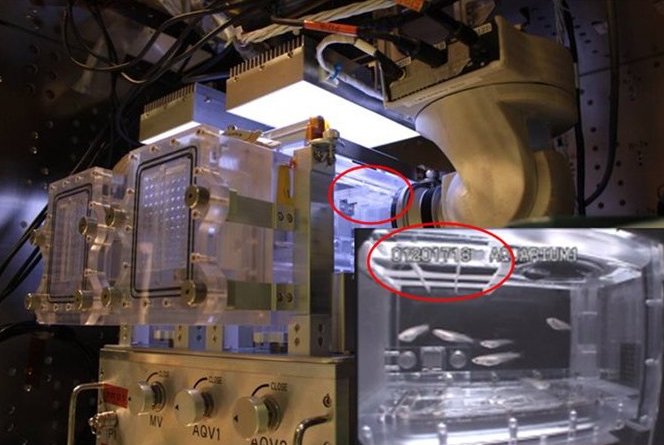Why Do We Send Animals to Space?

In 1957, a dog named Laika became the first Earthling to orbit her home planet. The furry cosmonaut looped around the Earth in the Sputnik 2 space capsule, preceding the first human space traveler by nearly four years.
When Laika made her historic trip, it was still unclear whether humans could survive in space, even for a few hours. She was, almost literally, a canary in a coal mine.
"We didn't even know if humans would be able to digest their food [in space]," Julie Robinson, NASA's chief scientist for the International Space Station, said of those early days of human spaceflight. "We were concerned … that humans might suffocate on the contents of [their] own stomachs if it all went floating up," she told Space.com. [Photos of Pioneering Animals in Space]
Laika died during her historic flight, but she and the other animals sent to space in those very early tests helped scientists begin to answer the question, what happens to the human body in space? Broadly speaking, scientists are still trying to answer that question — albeit at a much more nuanced level than they were in 1957.
Sending animals to space began as a way to make sure that human astronauts could survive in space at all. As spaceflight programs began to evolve in the 1960s and 1970s, space offered scientists the opportunity to "turn off" gravity, a variable they could never fully eliminate on Earth. By the 1980s, people were using space to conduct experiments that would directly impact the health of human beings on the ground — an application that the scientists conducting those first animal tests in the 1940s might never have anticipated.
Today, animal tests are helping scientists prepare for the hazards that humans will face if they ever want to visit Mars or live on the surface of the moon for prolonged periods of time.
The first space travelers

Laika the dog may be the most famous animal that ever traveled to space, although the American space traveler Ham the chimpanzee experienced a fair amount of celebrity in 1961, when he safely returned to Earth after a short trip to space. Three months later, NASA astronaut Alan Shepard became the first American human to cross that boundary.
Get the Space.com Newsletter
Breaking space news, the latest updates on rocket launches, skywatching events and more!
"People didn't know what would happen to humans in space, or what would happen to life in space," Brad Carpenter, chief scientist for NASA's Space Life and Physical Sciences Research and Applications Division, told Space.com.
The first living beings ever sent to space were fruit flies, launched in 1947 — and they made it back to Earth alive. Between 1948 and 1951, NASA conducted flight tests with six rhesus monkeys, all given the name Albert followed by a Roman numeral. Albert II became the first primate to reach space, but Albert VI (who was also called Yorick) was the only one who survived long enough to be rescued from his space capsule. He died shortly afterward, possibly due to the heat and stress of being trapped inside it. All told, in the 1950s, the Soviet and American space programs sent mice, rats, dogs, monkeys and a rabbit into space. [Photos: Pioneering Animals in Space]

After humans ventured into orbit in the early 1960s and Americans made it all the way to the moon in 1969, the frequency of animal space flights decreased, according to Carpenter and the NASA history website. The focus of animal flights after that point began to change as well; by the late 1960s, both the Soviet Union and the U.S. were sending a much wider variety of life-forms to space, including jellyfish, tortoises, frog eggs, microorganisms, spiders, amoebae and algae. Scientists were asking not only if life could survive in space, but how different kinds of life-forms might thrive and develop there.
In 1973, NASA put two cross spiders into orbit aboard Skylab, where they spun webs in the weightless environment for 59 days. (The webs were sloppy at first as the spiders adjusted to their environment but eventually came to look identical to webs spun by spiders on the ground. A similar experiment was conducted aboard the International Space Station in 2008.) In 1988, NASA sent frog eggs into space and found that even in the absence of gravity, they successfully hatched into tadpoles. Modeling physiological development is extremely difficult, Carpenter said, so it would have been essentially impossible to predict, without a physical experiment, what would happen to these systems in the absence of gravity.
And not all animals develop normally in weightlessness. In 1998, the Neurolab mission sent more than 2,000 living creatures on a 16-day flight aboard the Space Shuttle Columbia, to help scientists learn how microgravity affects balance, sensory integration, sleep, blood pressure control and nervous system development. The shuttle crewmembers were part of the experiments, along with rats, mice, crickets, snails and two kinds of fish.
The experiments showed that, in the absence of gravity, crickets don't develop organs that help them balance (sort of like the inner ear in humans) the way they do on Earth.
Many key ground-based experiments that involved a physiological process affected by gravity have since been repeated in orbit, Robinson said. Removing gravity from those same experiments can reveal new information. Those results, in turn, feed into a larger body of knowledge that can be applied to solving human and animal health issues on the ground.
In the human crewmembers, Neurolab looked at how a person's sense of balance changes in the absence of gravity. (Astronauts have noted a drastic loss of balance, but not necessarily dizziness, immediately after returning from space.)
The study also looked at astronaut sleep patterns. To learn about the human nervous system, the experiments looked at the way nerves respond to anticipated stimuli. For example, when a ball comes flying toward a person on Earth, the body anticipates its arrival, and that person's muscles automatically clench. In space, the ball doesn't accelerate (because there is no gravity), so it won't travel as fast as it does on Earth; but a person's muscles still clench in anticipation. That suggests the brain has an internal sense of how gravity should work.
Each of the species included in the Neurolab experiment was selected because it provided the best means of answering a specific question. In the crickets, it was possible to watch the development of an organ over a short period of time. The snails possessed very large neurons that were ideal for studying nervous system development, Robinson said.

"We're always going to be looking for the simplest organism we can fly that answers a scientific question," Carpenter said. "We have an ethical obligation, and we have policy and regulation that require us to do that. We can't inappropriately use a vertebrate organism for research."
There are regulations for animal testing that apply to agencies or universities that accept federal funding, and that includes NASA, Robinson said. Those regulations require clear justification for using animals in experiments, as opposed to some alternative. In addition, there is "a [NASA] committee that reviews [the experiment] to make sure that you've had the minimum impact, that you've minimized distress on the organism and so forth."
According to an article on NASA's own website from 2004, "Animal housing rules are more extensive than the requirements for human children day care centers. NASA facilities that house animals for research are accredited by an organization that requires proof that animals are cared for in a facility that meets those standards."
Staying healthy in space
Today, spaceflight scientists are focusing their research on a human trip to Mars.
One of the greatest threats to humans traveling to distant locations such as the moon or Mars is space radiation. Without the protective layers of the Earth's atmosphere and its magnetic field, the powerful particles coming from space are free to wreak havoc on human cells. It's also possible that the human body might respond differently to radiation in weightlessness, Robinson said. [Mice of Mars: Rodents Pave Way to Red Planet]
To get a better understanding of the severity of that threat, scientists are studying Drosophila, better known as fruit flies.
According to Robinson, about 15 percent of the National Institutes of Health's research is done on Drosophila. "They have a surprising number of genes in common with us," she said. "There are versions of Drosophila that, when exposed to a little bit of extra radiation, are more likely to develop a tumor. And so they were used as a model organism for a study of the interaction between radiation and microgravity."
This type of experiment is an example of how space-based animal testing has evolved to the point where it is essentially an extension of animal testing on Earth.
"We use animals for biomedical research in space for the same reason that we use [them] for biomedical research here on Earth," Robinson said. "It's a way of having a large sample size to study processes that you couldn't study in a human or that would take too long to study in a human."
Scientists are doing what they can to use Earth-based experiments to study the effects of space radiation on the human body (and how to protect them from it). But Robinson said most of those experiments can't replicate the long-term radiation exposure absorbed by most astronauts. It's also impossible to perfectly replicate on Earth the kind of radiation that comes from space (also called the "spectrum" of radiation), and even the International Space Station is in a more protected location than the empty space between Earth and Mars. Therefore, it's possible that before humans go to Mars, scientists might send animals into an orbit around the moon, for example, Robinson said. But there would have to be a compelling and specific reason for sending animals to the moon, to Mars ahead of humans or with the human mission to the Red Planet, she said.
But in the future, when scientists can expand their laboratories beyond the International Space Station, animal testing may take place in deep space, where it could help reveal more secrets about animal and human physiology, said the researchers said.
Recently, a group of researchers at NASA's Langley Research Center came up with an idea for a mouse habitat that would orbit the moon and rotate in such a way as to create artificial gravity (this spinning method of creating artificial gravity has been explored science fiction, including in "2001: A Space Odyssey" and "Interstellar."). In addition, the mice would be able to live on the habitat long enough to reproduce, so scientists could see how the environment would affect the mice over multiple generations. However, the researchers proposed the idea as part of an internal award that encourages Langley employees to come up with big, futuristic ideas — so there are currently no plans to make the habitat a reality.
Currently, on the International Space Station, NASA has a rodent habitat system and is in the process of developing a fruit fly system. The Japanese space agency, JAXA, operates an aquarium on the station, and both JAXA and the Italian Space Agency operate rodent habitats.
"So all of those, I think, are a sign of stepping up to use model organisms to answer some of the key questions for going to Mars," Robinson said.
Not just scientists
The weightless environment of space might seem like a healthy place to live; after all, it's impossible to fall and break a limb, and a person might find relief from the lower back pain and aching joints that follow a long day of standing up.
But the human body needs gravity; without it, muscles atrophy and bones weaken. Animal studies, particularly those in rodents, have been critical to helping astronauts avoid some of those harmful effects.

The type of weakening seen in space is very similar to what happens to people naturally as they grow old, and to people with degenerative muscle and bone diseases.
The silver lining of these negative effects is that space can be used to treatments that target those symptoms. For example, during the construction of the International Space Station, NASA conducted a mouse experiment in collaboration with the pharmaceutical company Amgen, Robinson said. The study looked at a drug that is now used to treat bone loss in chemotherapy patients and people with osteoporosis. More recently, the same company used a second round of space testing to investigate another osteoporosis drug.
"If you want to study osteoporosis on Earth in a rodent model, you have to do something to the mice so that they have bone loss that matches the bone loss in women who have osteoporosis," Robinson said. "So there are different techniques that are used, each of which have some limitations."
Spaceflight appears to be the quickest and most accurate way to replicate the symptoms that these pharmaceutical companies are trying to treat. (Mice obviously aren't perfect analogues for humans, but in biomedical research, they are "a step along the way" to finding out how a drug or treatment will work in people, Robinson said).
Pharmaceutical companies that want to run tests on the space station typically cover the costs of their experiments. Commercial research on the ISS is managed by the Center for the Advancement of Science in Space (CASIS). The station is identified as a national laboratory that is managed by CASIS, and it is available to researchers all over the world who want to apply to conduct research there. Nonprofit scientific groups can also apply directly to NASA to send experiments to the space station.
Even when those experiments aren't directly aimed at, for example, developing a new osteoporosis drug, there can still be benefits for humans on the ground. Studying physiology in the absence of gravity contributes to a larger understanding of physiology in general. For example, Neurolab's investigation into impaired balance in astronauts offered insight into why that symptom appears in people with certain neurological diseases.
Bringing private companies into low Earth orbit is beneficial for NASA's long-term plans; agency officials have said multiple times that they would like to share the responsibility of maintaining a human presence in low Earth orbit with private companies. That way, NASA can invest its money in more ambitious projects, like a human mission to Mars.
Animals have been a part of humanity's journey beyond Earth from the very beginning. As human spaceflight programs have evolved, so have the reasons for sending animals to space. As humanity pushes farther into space, and commercial companies (not just countries) take advantage of the resources there, the role of animals will likely evolve as well, helping humans answer questions they otherwise could not.
Follow Calla Cofield @callacofield. Follow us @Spacedotcom, Facebook and Google+. Original article on Space.com.
Join our Space Forums to keep talking space on the latest missions, night sky and more! And if you have a news tip, correction or comment, let us know at: community@space.com.

Calla Cofield joined Space.com's crew in October 2014. She enjoys writing about black holes, exploding stars, ripples in space-time, science in comic books, and all the mysteries of the cosmos. Prior to joining Space.com Calla worked as a freelance writer, with her work appearing in APS News, Symmetry magazine, Scientific American, Nature News, Physics World, and others. From 2010 to 2014 she was a producer for The Physics Central Podcast. Previously, Calla worked at the American Museum of Natural History in New York City (hands down the best office building ever) and SLAC National Accelerator Laboratory in California. Calla studied physics at the University of Massachusetts, Amherst and is originally from Sandy, Utah. In 2018, Calla left Space.com to join NASA's Jet Propulsion Laboratory media team where she oversees astronomy, physics, exoplanets and the Cold Atom Lab mission. She has been underground at three of the largest particle accelerators in the world and would really like to know what the heck dark matter is. Contact Calla via: E-Mail – Twitter









